|
Changing a recipe
is a very common task performed by glaze calculation software. In
the Recipe to Formula environment the recipe to be changed is first
loaded into a recipe panel.
Substituting
a Material
Frequently you
may wish to substitute one material for another. In this example
we will substitute the Whiting in the Cone 10 Glaze for Wollastonite.
We will make
this change and try to make other adjustments to maintain the original
unity formula.
While we are
making the changes we will want to keep an ey on the original formula
and perhaps the original recipe so our first task is to make a copy
of the formula and recipe in the Recipe to Formula environment.
Make
a copy of the Cone 10 Glaze
After the Cone
10 Glaze is loaded into the R.1 panel in the Recipe to Formula environment
click on the  button. This will place a copy of the formula in the second formula
column. Changes made to the recipe in R.1 panel will generate a
new formula in the first formula column.
button. This will place a copy of the formula in the second formula
column. Changes made to the recipe in R.1 panel will generate a
new formula in the first formula column.

Fig.1
Copying the recipe to the R.2 panel (not visible in this view)
|
If you
want to view the original recipe while making changes then
click the  button and the original recipe will be displayed in the R.2
panel.
button and the original recipe will be displayed in the R.2
panel.
The key
to making a successful material substitution in a recipe to
to ensure that at the end of the process the unity formula
for the new recipe is the same as that for the original and
that as few materials have been changed as possible.
In our
example changing the Whiting to Wollastonite will alter the
balances of all the other oxides in the recipe.
We will
need then to tinker with the new recipe's quantities to bring
the balances back the what they were in the original.
|
Selecting
Wollastonite to Replace Whiting
Click on the
name Whiting in the recipe panel then click on the  button to open the Materials Selection List. (or double click on
the name Whiting).
button to open the Materials Selection List. (or double click on
the name Whiting).
Locate and double
click on Wollastonite. This material will now replace Whiting
in the recipe and a new formula is generated in the first formula
column (under the  image).
image).
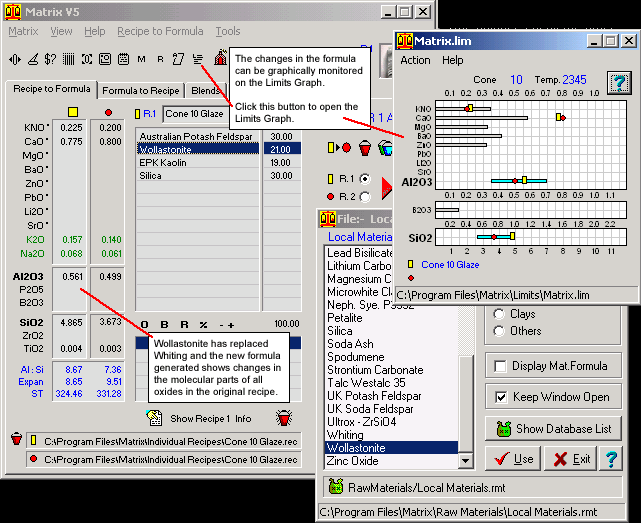
Fig.2
Using the Limits Graph to monitor changes in the formula. |
Fig.2 shows
the new formula generated after the Wollastonite replacement. We
can now close the Materials Selection window and start adjusting
the recipe's quantities to try to match the new formula with the
original.
Manipulating
the Recipe's Quantities to Match the Original Formula
We can start
with the Australian Potash Feldspar which is the source of KNO (K2O
& Na2O) in the recipe. The KNO level is too hight in the new
formula so click on the feldspar's quanties and type in a lower
number (don't forget to press the ENTER key). Keep on typing in
a new number until the small yellow rectangle (new formula value)
for KNO on the Limits graph lies on top of the red spot (the original
value for KNO). If you are very particular you can check the actual
values in the formula columns.
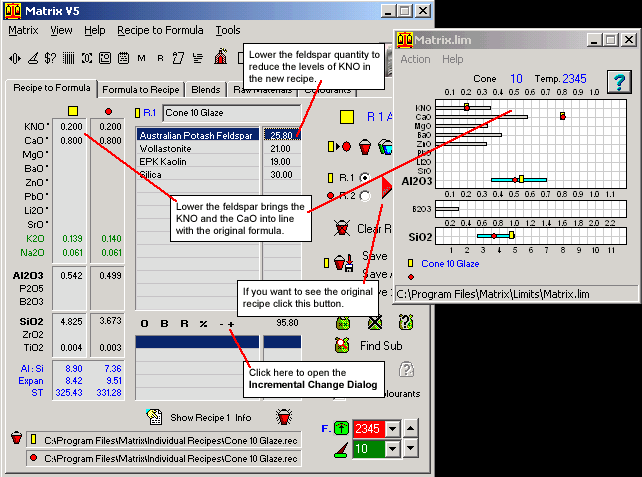
Fig.3
Lowering feldspar quantity to reduce the KNO levels and bring
the CaO back to that of the original. |
Now we have
to bring the Al2O3 and SiO2 levels in the new formula back in line
with those of the original formula. Click on the EPK Kaolin quantity
and type in lower numbers until the Al2O3 level (indicated by the
yellow rectngle on the graph) is the same as that in the original
formula (indicated by the red spot on the graph).See Fig.4
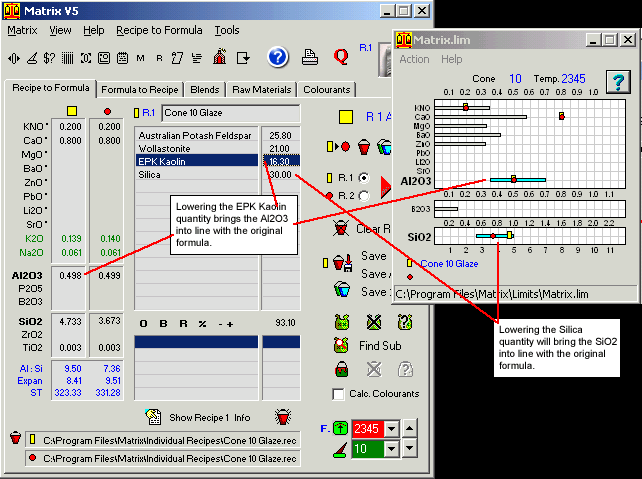
Fig.4
Lowering clay and silica quantities to reduce theAl2O3 and SiO2
levels to aline with the original formula. |
The final step
will be to convert the new recipe's quantities such that the total
is 100 See Fig. 5
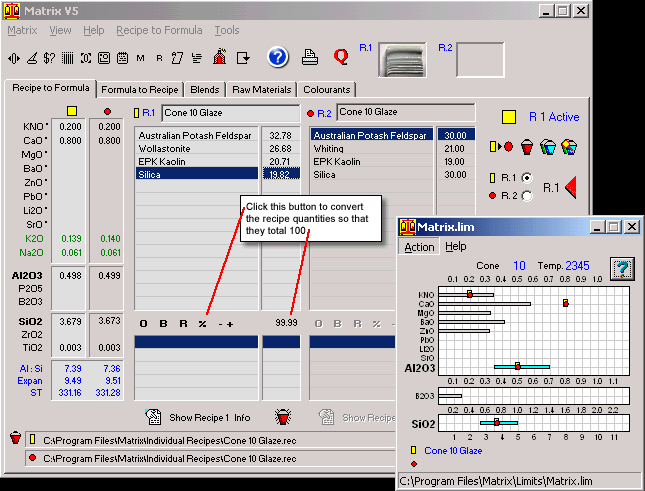
Fig.5
The conversion is complete. |
Using
the Incremental Change Dialog
While typing
in quantities in the recipe panel is the most direct way of making
changes this is sometimes less convenient than using the Incremental
Change Dialog which can change values in preset increments with
button clicks.
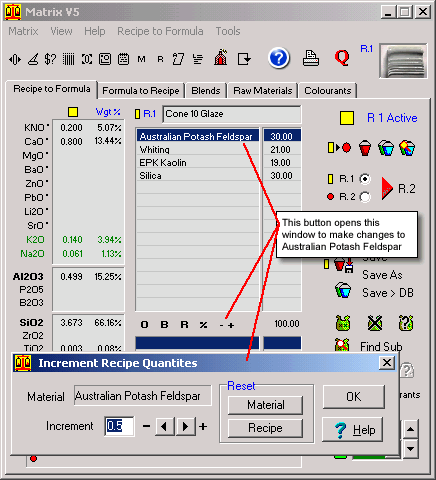
Fig.6
Opening the Incremental Change dialog. |
The Incremental
Change Dialog performs changes to a highlighted material
in a recipe.
To open
the window:
- click
on the material the quantity for which you wish to change
- click
on the
 button in the panel under the recipe you are changing (Fig.6)
button in the panel under the recipe you are changing (Fig.6)
We can
now use the buttons in the dialog to make changes to the quantity
of Australian Potash Feldspar highlighted in the recipe panel.
|

Fig.7
the Incremental Change dialog set to make changes to Australian
Potash Feldspar |
The increment
value can be changed in the dialog by typing a new number into the
Increment text box.
To change another
material with the dialog open just click on the material in the
recipe you wish to change.
When changes
are complete click the OK button.
Rename
and Save the New Recipe
All that remains
is to save the new recipe preferable with a name that indicates
it is a version of the original recipe e.g. Cone 10 Glaze #1
Click the  Save As button or the
Save As button or the  Save > DB button to save
the new recipe.
Save > DB button to save
the new recipe.
This process
can be done much more quickly (takes about 10 seconds) using the
process which makes a new recipe from a formula in the Formula to
Recipe environment.
Follow
these links for more information about:
|

